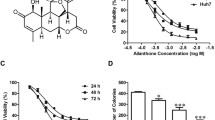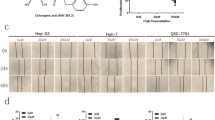Abstract
We have previously demonstrated that isocorydine (ICD) can be served as a potential antitumor agent in hepatocellular carcinoma (HCC). A novel derivate of isocorydine (d-ICD) could significantly improve its anticancer activity in tumors. However, the molecular mechanisms of d-ICD on HCC cells remain to be unclear. In this study, we observed that d-ICD inhibited cell proliferation and induced apoptosis of HCC cells in a concentration-dependent manner. We found d-ICD induced G2/M cycle arrest of HCC cells via DNA damage 45 alpha (GADD45A) and p21 pathway in vitro and in vivo. In d-ICD-treated cells, cell cycle-related proteins cyclin B1 and p-CDC2 were upregulated and p-cyclin B1, CDC2, and E2F1 were inhibited. p21 expression can be reversed by knockdown of GADD45A in d-ICD-treated HCC cells. Enforced expression of CCAAT/enhancer-binding protein β (C/EBPβ) in combination with d-ICD enhanced the p21 expression in HCC cells. Furthermore, the luciferase reporter assay showed that upregulation of GADD45A by C/EBPβ was achieved through the increase of GADD45A promoter activity. These findings indicate that d-ICD inhibits cell proliferation and induces cell cycle arrest through activation of C/EBPβ-GADD45A-p21 pathway in HCC cells. d-ICD might be a promising chemotherapeutic agent for the treatment of HCC.





Similar content being viewed by others

References
Llovet JM, Burroughs A, Bruix J. Hepatocellular carcinoma. Lancet. 2003;362:1907–17.
Bosch FX, Ribes J, Diaz M, Cleries R. Primary liver cancer: worldwide incidence and trends. Gastroenterology. 2004;127:S5–16.
Bloom J, Cross FR. Multiple levels of cyclin specificity in cell-cycle control. Nat Rev Mol Cell Biol. 2007;8:149–60.
Barreto G, Schafer A, Marhold J, Stach D, Swaminathan SK, Handa V, et al. Gadd45a promotes epigenetic gene activation by repair-mediated DNA demethylation. Nature. 2007;445:671–5.
Notas G, Alexaki VI, Kampa M, Pelekanou V, Charalampopoulos I, Sabour-Alaoui S, et al. April binding to bcma activates a JNK2-FOXO3-GADD45 pathway and induces a G2/M cell growth arrest in liver cells. J Immunol. 2012;189:4748–58.
Kim T, Cui R, Jeon YJ, Fadda P, Alder H, Croce CM. MYC-repressed long noncoding RNAs antagonize MYC-induced cell proliferation and cell cycle progression. Oncotarget. 2015;7:18780–9.
Vera J, Raatz Y, Wolkenhauer O, Kottek T, Bhattacharya A, Simon JC, et al. Chk1 and Wee1 control genotoxic-stress induced G2-m arrest in melanoma cells. Cell Signal. 2015;27:951–60.
Henley SA, Dick FA. The retinoblastoma family of proteins and their regulatory functions in the mammalian cell division cycle. Cell Div. 2012;7:10.
Matsuoka K, Iimori M, Niimi S, Tsukihara H, Watanabe S, Kiyonari S, et al. Trifluridine induces p53-dependent sustained G2 phase arrest with its massive misincorporation into DNA and few DNA strand breaks. Mol Cancer Ther. 2015;14:1004–13.
Sun H, Hou H, Lu P, Zhang L, Zhao F, Ge C, et al. Isocorydine inhibits cell proliferation in hepatocellular carcinoma cell lines by inducing G2/m cell cycle arrest and apoptosis. PLoS One. 2012;7:e36808.
Lu P, Sun H, Zhang L, Hou H, Zhang L, Zhao F, et al. Isocorydine targets the drug-resistant cellular side population through PDCD4-related apoptosis in hepatocellular carcinoma. Mol Med. 2012;18:1136–46.
Zhong M, Liu Y, Liu J, Di D, Xu M, Yang Y, et al. Isocorydine derivatives and their anticancer activities. Molecules. 2014;19:12099–115.
Yan M, Li H, Zhao F, Zhang L, Ge C, Yao M, et al. Establishment of NOD/SCID mouse models of human hepatocellular carcinoma via subcutaneous transplantation of histologically intact tumor tissue. Chin J Cancer Res. 2013;25:289–98.
Li H, Ge C, Zhao F, Yan M, Hu C, Jia D, et al. Hypoxia-inducible factor 1 alpha-activated angiopoietin-like protein 4 contributes to tumor metastasis via vascular cell adhesion molecule-1/integrin beta1 signaling in human hepatocellular carcinoma. Hepatology. 2011;54:910–9.
Tian H, Ge C, Li H, Zhao F, Hou H, Chen T, et al. Ribonucleotide reductase m2b inhibits cell migration and spreading by early growth response protein 1-mediated phosphatase and tensin homolog/akt1 pathway in hepatocellular carcinoma. Hepatology. 2014;59:1459–70.
Liu L, Cao Y, Chen C, Zhang X, McNabola A, Wilkie D, et al. Sorafenib blocks the RAF/MEK/ERK pathway, inhibits tumor angiogenesis, and induces tumor cell apoptosis in hepatocellular carcinoma model PLC/PRF/5. Cancer Res. 2006;66:11851–8.
Llovet JM, Ricci S, Mazzaferro V, Hilgard P, Gane E, Blanc JF, et al. Sorafenib in advanced hepatocellular carcinoma. N Engl J Med. 2008;359:378–90.
Liu K, Liu S, Zhang W, Ji B, Wang Y, Liu Y. Mir222 regulates sorafenib resistance and enhance tumorigenicity in hepatocellular carcinoma. Int J Oncol. 2014;45:1537–46.
Simioni C, Cani A, Martelli AM, Zauli G, Alameen AA, Ultimo S, et al. The novel dual PI3K/mTOR inhibitor NVP-BGT226 displays cytotoxic activity in both normoxic and hypoxic hepatocarcinoma cells. Oncotarget. 2015;6:17147–60.
Sakaue-Sawano A, Kobayashi T, Ohtawa K, Miyawaki A. Drug-induced cell cycle modulation leading to cell-cycle arrest, nuclear mis-segregation, or endoreplication. BMC Cell Biol. 2011;12:2.
Hall M, Peters G. Genetic alterations of cyclins, cyclin-dependent kinases, and Cdk inhibitors in human cancer. Adv Cancer Res. 1996;68:67–108.
Coqueret O. New roles for p21 and p27 cell-cycle inhibitors: a function for each cell compartment? Trends Cell Biol. 2003;13:65–70.
Li D, Kang N, Ji J, Zhan Q. BRCA1 regulates transforming growth factor-beta (TGF-beta1) signaling through Gadd45a by enhancing the protein stability of Smad4. Mol Oncol. 2015;9:1655–66.
Shi Y, Massague J. Mechanisms of TGF-beta signaling from cell membrane to the nucleus. Cell. 2003;113:685–700.
Kearsey JM, Coates PJ, Prescott AR, Warbrick E, Hall PA. Gadd45 is a nuclear cell cycle regulated protein which interacts with p21Cip1. Oncogene. 1995;11:1675–83.
Cretu A, Sha X, Tront J, Hoffman B, Liebermann DA. Stress sensor Gadd45 genes as therapeutic targets in cancer. Cancer Ther. 2009;7:268–76.
Kastan MB, Zhan Q, el Deiry WS, Carrier F, Jacks T, Walsh WV, et al. A mammalian cell cycle checkpoint pathway utilizing p53 and Gadd45 is defective in ataxia-telangiectasia. Cell. 1992;71:587–97.
Takekawa M, Saito H. A family of stress-inducible Gadd45-like proteins mediate activation of the stress-responsive MTK1/MEKK4 MAPKKK. Cell. 1998;95:521–30.
Wang XW, Zhan Q, Coursen JD, Khan MA, Kontny HU, Yu L, et al. Gadd45 induction of a G2/m cell cycle checkpoint. Proc Natl Acad Sci U S A. 1999;96:3706–11.
Ma L, Liu J, Liu L, Duan G, Wang Q, Xu Y, et al. Overexpression of the transcription factor MEF2D in hepatocellular carcinoma sustains malignant character by suppressing G2-m transition genes. Cancer Res. 2014;74:1452–62.
Sun Y, Tang S, Xiao X. The effect of Gadd45a on furazolidone-induced S-phase cell-cycle arrest in human hepatoma G2 cells. J Biochem Mol Toxicol. 2015. doi:10.1002/jbt.21719.
Fornace Jr AJ, Nebert DW, Hollander MC, Luethy JD, Papathanasiou M, Fargnoli J, et al. Mammalian genes coordinately regulated by growth arrest signals and DNA-damaging agents. Mol Cell Biol. 1989;9:4196–203.
Tamura RE, de Vasconcellos JF, Sarkar D, Libermann TA, Fisher PB, Zerbini LF. Gadd45 proteins: central players in tumorigenesis. Curr Mol Med. 2012;12:634–51.
Sun L, Gong R, Wan B, Huang X, Wu C, Zhang X, et al. Gadd45gamma, down-regulated in 65% hepatocellular carcinoma (HCC) from 23 Chinese patients, inhibits cell growth and induces cell cycle G2/m arrest for hepatoma Hep-G2 cell lines. Mol Biol Rep. 2003;30:249–53.
Zhang L, Yang Z, Ma A, Qu Y, Xia S, Xu D, et al. Growth arrest and DNA damage 45G down-regulation contributes to Janus kinase/signal transducer and activator of transcription 3 activation and cellular senescence evasion in hepatocellular carcinoma. Hepatology. 2014;59:178–89.
Wang H, Iakova P, Wilde M, Welm A, Goode T, Roesler WJ, et al. C/EBPalpha arrests cell proliferation through direct inhibition of Cdk2 and Cdk4. Mol Cell. 2001;8:817–28.
Zhu S, Yoon K, Sterneck E, Johnson PF, Smart RC. CCAAT/enhancer binding protein-beta is a mediator of keratinocyte survival and skin tumorigenesis involving oncogenic Ras signaling. Proc Natl Acad Sci U S A. 2002;99:207–12.
Lane MD, Tang QQ, Jiang MS. Role of the CCAAT enhancer binding proteins (C/EBPS) in adipocyte differentiation. Biochem Biophys Res Commun. 1999;266:677–83.
Tang QQ, Lane MD. Activation and centromeric localization of CCAAT/enhancer-binding proteins during the mitotic clonal expansion of adipocyte differentiation. Genes Dev. 1999;13:2231–41.
Panka DJ, Wang W, Atkins MB, Mier JW. The Raf inhibitor BAY 43-9006 (sorafenib) induces caspase-independent apoptosis in melanoma cells. Cancer Res. 2006;66:1611–9.
Acknowledgments
This work was supported in part by grants from the National Key Program for Basic Research of China (973) (2015CB553905), National Natural Science Foundation of China (81272438, 81472726, 81472570, 81372192, 31360603), Key Discipline and Specialty Foundation of Shanghai Municipal Commission of Health and Family Planning, the National KeySci-Tech Special Project of China (2013ZX10002-011), Innovation Program of Shanghai Municipal Education Commission (13ZZ082), and the SKLORG Research foundation (91-13-02, 91-14-09).
Author information
Authors and Affiliations
Corresponding author
Ethics declarations
Conflicts of interest
None
Additional information
Lijuan Chen and Hua Tian contributed equally to this work.
Electronic supplementary material
Below is the link to the electronic supplementary material.
ESM 1
(DOC 820 kb)
Rights and permissions
About this article
Cite this article
Chen, L., Tian, H., Li, M. et al. Derivate isocorydine inhibits cell proliferation in hepatocellular carcinoma cell lines by inducing G2/M cell cycle arrest and apoptosis. Tumor Biol. 37, 5951–5961 (2016). https://doi.org/10.1007/s13277-015-4362-6
Received:
Accepted:
Published:
Issue Date:
DOI: https://doi.org/10.1007/s13277-015-4362-6



